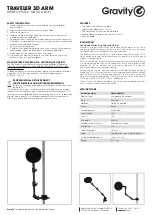
Operating basics
The Color Key colors:
If the prior symbol was in Quadrant 1 (upper right) then the current symbol
is colored Yellow
If the prior symbol was in Quadrant 2 (upper left) then the current symbol is
colored Magenta
If the prior symbol was in Quadrant 3 (lower left) then the current symbol
is colored light blue (Cyan)
If the prior symbol was in Quadrant 4 (lower right) then the current symbol
is colored solid Blue
Eye diagrams
Eye diagram plots can be selected for appropriate modulation formats by clicking
on the eye-diagram icon and selecting an eye format. Supported eye formats
include
fi
eld Eye (which is simply the real part of the phase trace in the complex
plane), Power Eye (which simulates the Eye displayed with a conventional
oscilloscope optical input), and Diff-Eye (which simulates the Eye generated by
using a 1-bit delay-line interferometer). As with the Constellation Plot you can
right-click to choose color options as well.
The
fi
eld Eye diagram provides the following measurements:
Q (dB): Computed from 20*Log10 of the linear decision threshold Q-factor
of the eye
Eye Height: The distance from the mean one level to the mean zero level
(units of plot)
Rail0 Std Dev: The standard deviation of the 0-Level as determined from the
decision threshold Q-factor measurement
Rail1 Std Dev: The standard deviation of the 1-Level as determined from the
decision threshold Q-factor measurement
In the case of multi-level signals, the above measurements will be listed in
the order of the corresponding eye openings in the plot. The top row values
correspond to the top-most eye opening.
The above functions involving Q factor use the decision threshold method
described in the paper by Bergano
. When the number of bit errors in the
measurement interval is small, as is often the case, the Q-factor derived from the
bit error rate may not be an accurate measure of the signal quality. However, the
decision threshold Q-factor is accurate because it is based on all the signal values,
not just those that cross a de
fi
ned boundary.
1
N.S. Bergano, F.W. Kerfoot, C.R. Davidson, “Margin measurements in optical ampli
fi
er systems,” IEEE Phot.
Tech. Lett., 5, no. 3, pp. 304-306 (1993).
46
OM4000D Series Coherent Lightwave Signal Analyzer
Содержание OM4006D
Страница 1: ...xx OM4106D and OM4006D Coherent Lightwave Signal Analyzer ZZZ User Manual P071316002 071 3160 02...
Страница 2: ......
Страница 6: ......
Страница 22: ...Compliance information xvi OM4000D Series Coherent Lightwave Signal Analyzer...
Страница 24: ...Preface xviii OM4000D Series Coherent Lightwave Signal Analyzer...
Страница 100: ...Taking measurements 76 OM4000D Series Coherent Lightwave Signal Analyzer...
Страница 132: ...Appendix A MATLAB variables used by core processing 108 OM4000D Series Coherent Lightwave Signal Analyzer...
Страница 146: ...Appendix D Automatic receiver deskew 122 OM4000D Series Coherent Lightwave Signal Analyzer...
Страница 176: ...Appendix F Configuring two Tektronix 70000 series oscilloscopes 152 OM4000D Series Coherent Lightwave Signal Analyzer...
Страница 202: ...Appendix H Cleaning and maintenance 178 OM4000D Series Coherent Lightwave Signal Analyzer...
Страница 205: ...Index W Waveform averaging 48 OM4000D Series Coherent Lightwave Signal Analyzer 181...
















































